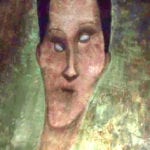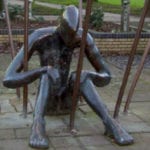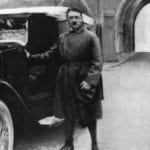 Mysteries
Mysteries  Mysteries
Mysteries  History
History 10 Surprising Stories About the Texas Rangers
 Humans
Humans 10 Philosophers Who Were Driven Mad by Their Own Theories
 Miscellaneous
Miscellaneous 10 Video-Game-Worthy Weapons and Armors from History
 Weird Stuff
Weird Stuff 10 Psychics Who Accurately Predicted Wartime Events
 The Arts
The Arts 10 Pieces of Art Inspired by a Broken Heart
 Health
Health 10 Science Fiction-Sounding New Medical Treatments
 History
History 10 Surprising Facts About the Father of Submarine Warfare
 Space
Space Ten Astonishing New Insights into Alien Worlds
 Weird Stuff
Weird Stuff 10 Bizarre Summer Solstice Rituals Still Practiced Today
 Mysteries
Mysteries Top 10 Haunting Facts About the Ghost Ship MV Alta
 History
History 10 Surprising Stories About the Texas Rangers
 Humans
Humans 10 Philosophers Who Were Driven Mad by Their Own Theories
Who's Behind Listverse?

Jamie Frater
Head Editor
Jamie founded Listverse due to an insatiable desire to share fascinating, obscure, and bizarre facts. He has been a guest speaker on numerous national radio and television stations and is a five time published author.
More About Us Miscellaneous
Miscellaneous 10 Video-Game-Worthy Weapons and Armors from History
 Weird Stuff
Weird Stuff 10 Psychics Who Accurately Predicted Wartime Events
 The Arts
The Arts 10 Pieces of Art Inspired by a Broken Heart
 Health
Health 10 Science Fiction-Sounding New Medical Treatments
 History
History 10 Surprising Facts About the Father of Submarine Warfare
 Space
Space Ten Astonishing New Insights into Alien Worlds
 Weird Stuff
Weird Stuff 10 Bizarre Summer Solstice Rituals Still Practiced Today
Top 10 Weird Images in Renaissance Paintings
Ah, the Renaissance. A period of tremendous social progression and scientific achievement. It was a cultural rescue from the stagnation of the Late Middle Ages, and most importantly, how the Ninja Turtles got their names. And though no legacy can compare to those totally tubular turtles, it’s also worth mentioning that the period produced some of the most famous art in history.
Renaissance art represented a huge advancement in realism due to the movement’s scientific investigations into anatomy, perspective, and light. This really comes through in its masterfully skillful paintings… most of the time. Any big leap forward is bound to have its stumbling points, and a lot of Renaissance paintings are evidence of that. Whether creepy, cryptic, or just downright puzzling, here are ten Renaissance paintings with images that are enlighten-mental.
10 Most Everything by Giuseppe Arcimboldo
Giuseppe Arcimboldo was a talented 16th-century Italian painter who spent his life painting lifelike but expressive portraits of nobles, their families, and their pets. His whole career was very standard and he never really found a way to stand out. Just kidding. He was a total weirdo who painted people made of fruit, cuts of meat, household objects, and even other people.
The funny thing is that Arcimboldo really could paint realistic portraits and the like, but he still dedicated his career to creating the weirdest fruit people you’ve ever seen. He would draw, for example, the Holy Roman Emperor as a sculpture made of vegetables—the firm head-of-cabbage shoulders are particularly flattering. Another gem is “The Cook,” which depicts the titular chef as a demonic assemblage of roasted pigs and pheasants. The casual absurdism of his work makes Arcimboldo the Eric Andre of Renaissance painters.
9 “The Creation of Adam” and His Brain
“The Creation of Adam” is one of the most famous paintings in history. You may know it as the ‘God doing the E.T. finger’ painting, as part of the Sistine Chapel’s ceiling, or as a hilarious set-piece from Arrested Development. Either way, the work is iconic. Painted at the beginning of the 1500s, it wasn’t until almost 500 years later that a doctor noticed an unusual and hidden anatomic detail to the painting.
Behind God are twelve figures (whose nature is debated) and a swirling pink cloak, all of which combine to form a surprisingly accurate outline of the human brain. Further, the folds in the cloak and placement of the figures and their limbs divide the brain into its major sections—cerebrum, frontal lobes, brain stem, its artery, and even smaller pieces like the pituitary gland—again to a high level of accuracy. Why Michelangelo did this is unknown, but the most dramatic take is that the artist was trying to sneak in his belief that God is a product of the human mind.
8 “The Ambassadors” and Their Skull
Hans Holbein the Younger painted “The Ambassadors” for one of two reasons: either to hide some Dan Brown-esque message or just to be a troll. At first glance, the work is just a double portrait, showing two men leaning on a shelf (and looking really unimpressed with the whole affair). But hidden in the painting, and not-so-hidden, are about a dozen weird details that historians still debate.
The most famous is the giant skull between the two men’s legs. Its presence is obvious from the start, but its true nature is obscured due to extreme anamorphosis—meaning you can only see its actual shape from a certain angle. It’s like those hyper-realistic sidewalk drawings that only look right from one specific spot, and otherwise look like funhouse mirror distortions. Why Holbein did this is unknown, but many scholars believe it is just because he could.
7 “An Allegory with Venus and Cupid” and Syphilis
Angolo Bronzino’s “An Allegory with Venus and Cupid” is another that looks quite normal at first glance. Heck, even at a second and third glance. But like most masterpieces, it’s been pored over again and again, generating at least one interesting take on the whole work: a warning of the dangers of syphilis.
Syphilis had just begun to ravage Europe in the decades before this painting was produced, and supposedly the work is about the disease from corner to corner. The painting is pretty blatantly sexual, and all its characters apparently pay the price. One is stabbed by a thorn and does not notice—like syphilitic nerve damage. There are also missing fingernails, swollen fingers, patchy alopecia, red eyes, and toothless gums—all either symptoms of syphilis or side effects from its treatment. The moral: even if you’re the goddess of love herself, reckless, unprotected sex is a big no-no.
6 “The Arnolfini Portrait” and the Weird Flex
When Jan van Eyck painted “The Arnolfini Portrait,” he wasn’t just after portraying a scene or its subjects; he wanted to flex his muscles. Van Eyck was a master, one of the best painters of his day, and is even credited with inventing the modern form of oil painting. “The Arnolfini Portrait” was his subtle, sneaky way of proving he could do even more.
The main painting shows a man and woman getting married and is simply masterful in its perspective and realism. But van Eyck blows that completely out of the water in just one small section. Hanging on the back wall of the scene is a mirror, and within the mirror, a perfect recreation of the scene from behind, including the mirror’s natural fish-eye effect. That’s right, within the painting is a whole other painting of the first painting from behind, and it displays a technical aptitude previously unseen in its field.
5 “The Garden of Earthly Delights” has Hidden Music
Hieronymus Bosch is famous for his surreal, symbolic, nightmarish depictions of religious scenery, like if Michelangelo and Salvador Dali had an old Dutch baby. His most famous works are big, sprawling altarpieces like “The Last Judgement,” “The Temptation of St. Anthony,” and most famous of all, “The Garden of Earthly Delights.”
The piece shows three scenes: one is likely Eden, one possibly Earth, and one Hell. Each is filled with dozens and dozens of trippy images, but one stands out. In the Hell scene, a series of musicians are tortured with their instruments, and one evidently was punished by having music tattooed on his butt. Well, one music student transcribed that music, and now we can all listen to the “600-year-old butt music from hell.”
4 The Voynich manuscript
Though not itself a painting, the infamous Voynich Manuscript contains dozens of paintings within it, and each is stranger than the last. The manuscript is a hand-written and hand-illustrated journal and from cover to cover is a complete mystery.
For one thing, the whole journal is written in its own unique language, which has never been successfully translated. It seems unlikely to be just a hoax, as the writing bears all the telltale signs of actual language. In addition, the book is filled with cryptic paintings that depict, among others: alien-like plants, ornate diagrams of unknown items/codes/philosophies, religious scenes of nymphs and angels, dragons, odd sculptures, and new constellations. The person who wrote the manuscript, why they wrote it, and what it was meant to be used for are still completely unknown, but it seems to come from somewhere in Italy in the 15th century.
3 “Madonna with Saint Giovannino” and a UFO
Domenico Ghirlandaio’s “Madonna with Saint Giovannino” is 99% normal religious Renaissance painting, but it’s the 1% that attracts attention. The painting is a scene of the Madonna, Saint John, and baby Jesus, and most notably- a little blob in the background sky.
The blob, which appears to be flying, is a grayish disk and emits glowing gold rays from all around it. Also in the background are a man and his dog. Both are looking up at the object, the man shielding his eyes from the harsh golden light. Naturally, many have interpreted this as a UFO and cite it as evidence of (semi-)ancient aliens.
2 “The Last Supper” Soundtrack
“The Last Supper” by Leonardo da Vinci is one of the most famous pieces of art in existence. Because of that, and because its subject material is the last supper of Christ with his apostles (including Judas the betrayer), it has been the subject of constant interpretation and reinterpretation by scholars. There are claims of numerology, a hidden Mary Magdalene, and more. Another is, and I can’t believe I’m typing this again, a hidden musical score in the painting.
Yes, apparently Bosch isn’t the only one. Using the table as a base to start the staff lines and the positions of the subjects’ hands and the pieces of bread they hold (symbols of the body of Christ) as music notes, a short piece emerges. It’s been described as a solemn requiem; a sad little piece meant to lament the impending death of Christ, which some interpret as a secret nod to da Vinci’s otherwise dubious faith.
1 Ugly Babies
This weird image isn’t in one painting but hundreds. For some reason, it took artists thousands of years to figure out what children look like. Hundreds of positively gorgeous scenes, with beautiful adult subjects and precise perspective, have been marred by puzzlingly ugly children. Not just ugly, but hideous, like little pint-size Steve Buscemi’s without the charm.
Ugly babies are such a common phenomenon that it has its own dedicated Tumblr, coffee-table books, and scholarly studies attempting to find the cause. One theory suggests that because Christian churches commissioned most paintings, their child subjects were all modeled after the baby Christ, who was born perfectly formed and unchanged. That would make him look like a tiny adult man, a DeVito if you will, and hence the baby’s ugliness. Whether this “homuncular Jesus” theory is right or not, it’s hard to explain away just how grotesque these little monsters were.








